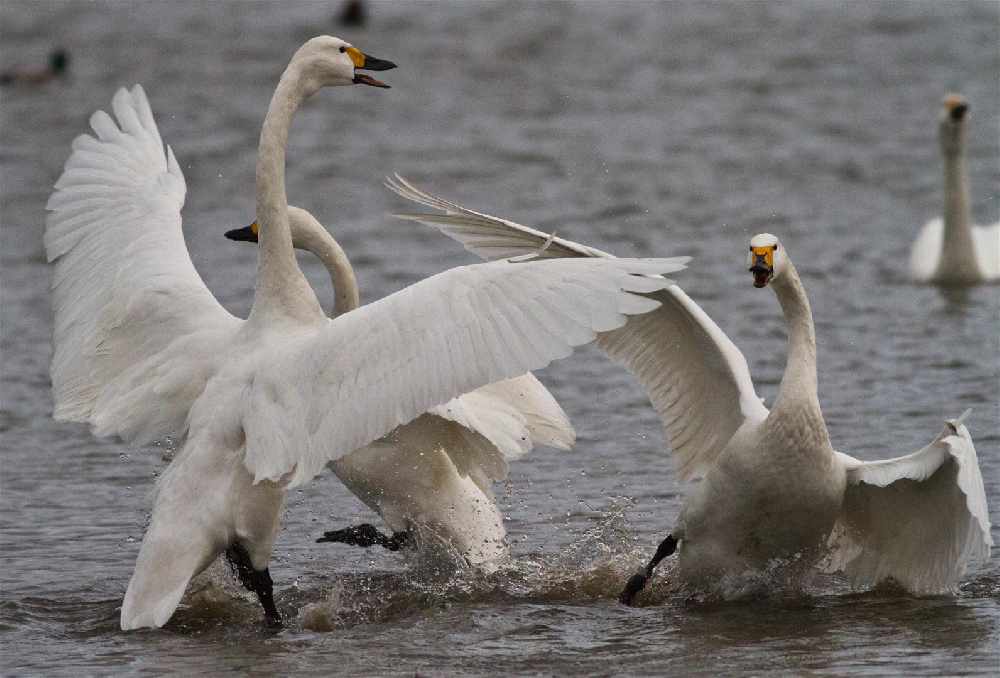
They attack each other most
Swans are the fighters of the avian world: the species most likely to display aggression to fellow swans than other birds.
New research jointly conducted with Exeter's Centre for Research in Animal Behaviour, based at Exeter University, examined three swan species – mute, whooper and Bewick's – and found all were most frequently aggressive to their own kind. They're after one another's food and shelter.
The Wildfowl and Wetlands Trust (WWT) joined with the University of Exeter to better understand how swan behaviour affects other waterbirds over winter. Dr Kevin Wood, principal research officer at WWT, said: “We know that swans have a reputation for aggressiveness but some of us suspected that in reality a lot of the aggression was directed towards other swans rather than smaller birds such as ducks or geese.
“To test that idea, we recruited some great students who used the webcams at Slimbridge and Caerlaverock to collect behavioural data on aggressive interactions between the various waterbirds at those sites over the past two winters. Our suspicions were right. In fact, almost all of the waterbird species in our study were most aggressive to their own species, which makes ecological sense as the individuals that are most similar to you are your greatest competition for food and other resources.
The study was carried out by monitoring live-stream webcams on reserves at WWT Slimbridge Wetland Centre in Gloucestershire and WWT Caerlaverock Wetland Centre in Dumfries over two years. It’s one of the first studies that has relied completely on remotely collected data – and could be one of the solutions to continuing research with restrictions in place during the covid-19 pandemic.
Dr Paul Rose, of Exeter's Centre for Research in Animal Behaviour, added: "We'd been thinking of using the WWT webcams for a while, to learn more about the swans' behaviour without disturbing them, and this project on aggression and species differences seemed to beneficial to the needs of WWT's conservation work and to the students fulfilling the requirements of their degrees."
Across whooper, Bewick’s and mute swans, infighting between the same species accounted for up to 80 per cent of negative interactions. Bewick’s swans in particular were more likely to behave aggressively with one another, which could reflect their extreme lifestyles which involve a 7,000km migration across a continent twice a year.
The number of wintering Bewick’s swans in the UK declined by more than half between 1995 and 2015, with numbers continuing to fall.
Conservationists thought this may be due to competing with mute and whoopers swans at their winter sites in Europe and at summer sites in Arctic Russia. However, these findings show this is unlikely.
The study has also helped demonstrate how remotely-collected data can inform scientific research, without causing as much disturbance to birds and reducing carbon footprint in terms of travel. It is likely to become an increasingly useful tool as conservationists try to carry out research while potential for field-work is limited. The next step is to study other waterbirds to see how their behaviour alters depending on the presence and number of swans.
The paper, published in the journal Avian Research, is entitled: "Aggressive behavioural interactions between swans (Cygnus spp.) and other waterbirds during winter: a webcam-based study."
 New service station could be built near Barnstaple
New service station could be built near Barnstaple
 Devoncast- Murder in Sidmouth with Jeremy Vine, crumbling cliffs and fake tweets for the birds
Devoncast- Murder in Sidmouth with Jeremy Vine, crumbling cliffs and fake tweets for the birds
 Concern as under half of Devon residents eat their 5-a-day
Concern as under half of Devon residents eat their 5-a-day
 Dawlish cliffs could collapse at any time
Dawlish cliffs could collapse at any time
 Two murders in Cornwall
Two murders in Cornwall
 Councillor owes more than £3,000 in council tax
Councillor owes more than £3,000 in council tax
